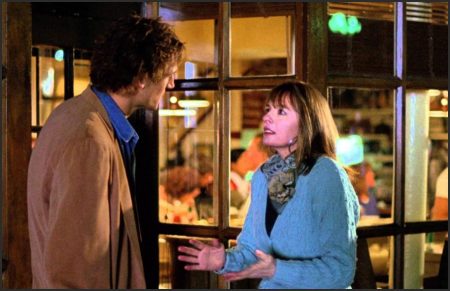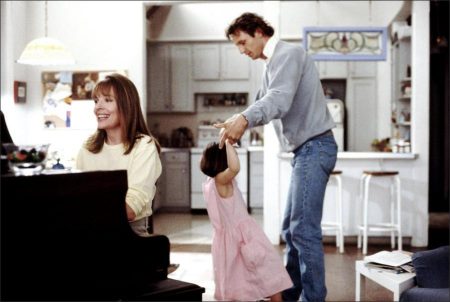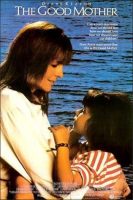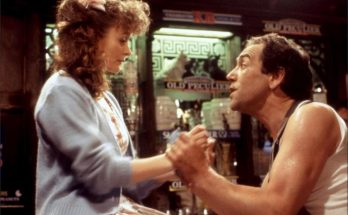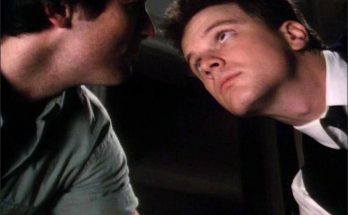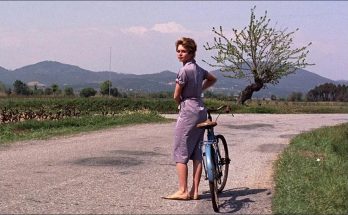The Good Mother movie synopsis. Anna Dunlap (Diane Keaton), is a piano teacher who works part-time at a college laboratory and a recent divorcee who has custody of a six-year-old daughter. She meets and falls in love with Leo (Liam Neeson), an Irish sculptor who helps her to find true passion and fulfillment. But her sexual liberation comes at a very high cost: her ex-husband Brian (Naughton) questions her new lifestyle. Worse, he accuses Leo of sexually molesting Molly and sues Anna for custody of their daughter.
The Good Mother is a 1988 American drama film and an adaptation of Sue Miller’s novel of the same name. Directed by Leonard Nimoy, the film stars Diane Keaton and Liam Neeson in the leading roles. The Good Mother explores feelings and beliefs about children’s exposure to adult sexuality and challenges society’s growing reliance upon courts to settle complex private and ethical matters.
Film Review for The Good Mother
Warning: Even if you haven’t seen “The Good Mother,” I am going to reveal the film’s ending here. Ordinarily, I consider spoiling the suspense of a story an act of verbal vandalism, but “The Good Mother” is such a stupid, mean-spirited, wrong-headed, morally corrupt movie that it doesn’t inspire respect for its privacy.
The artistry is not in question here. It is arguably a slickly packaged, well-acted,technically well-made movie, a competent translation of a popular novel. But behind its pretty face lurks an ugly point of view.
Diane Keaton is Anna Dunlap, the divorced mother of a 6-year-old girl. Little Molly spills her milk and Anna laughs. She totters around in her mother’s high heels and ol’ Mom indulgently smiles. They giggle together at the pictures in a children’s book on reproduction. Anna finds Molly’s every move amusing and adorable.
Molly quickly takes to Leo, Anna’s sculptor-lover. One evening as he baby-sits, Molly catches him stepping from the shower and asks if she can touch his penis. He is flustered, but having observed that Anna fosters an atmosphere of openness with Molly, he says yes. Girl tells her father, father sues for custody, everybody goes to court and Mom loses girl.
(Editor’s note: In the book’s stronger version of the shower scene, toned down for filming, Leo was aroused to erection by “the contact, and… the weirdness of the situation.”)
Oops! Molly’s curiosity is not so amusing. The subject is sex, and when Anna is confronted by Molly’s encounter with real flesh, not cute illustrations in a picture book, the child’s behavior is suddenly not adorable. It is bad, and Anna is a bad mother for letting her sex life encroach on her daughter’s reality. She is so wrong that she must be punished. She is vilified by her ex-husband’s contempt, patronized by her lawyer, penalized by the state.
Finally, screenwriter Michael Bortman and author Sue Miller strip Anna’s existence of mature love and sexuality. Innocent, hapless Leo is banished and Anna is left with her visitation rights–thoroughly chastised and, once again, chaste.
Why? For choosing a lover who doesn’t think too quickly on his feet? Or for being a single mother who doesn’t live in a constant state of sexual denial?
In his introduction to the published script of his movie “True Stories,” David Byrne wrote, “Most movies show you something and tell you how you’re supposed to feel about it.” At the end of “The Good Mother,” we’re supposed to feel sorry for Anna. But I’m afraid we’re also supposed to feel superior, smug in the knowledge that we would never be such careless parents.
But being a parent is about making mistakes. No other job is done by so many who are so untrained and ill-prepared. The psychiatric couches of America are littered with neurotics whose parents unintentionally screwed them up.
But the implication is that Anna Dunlap’s mistake is unforgivable. It is about sex and sex is nasty. All her good mothering pales beside the horror of her poor judgment in exposing her daughter to nudity and sex. In fact, the movie’s message seems to be that Anna is a bad mother because she not only has sex but also enjoys it.
More than one female reviewer has noted that newcomer Liam Neeson’s Leon generates more heat than a microwave. This dream man is bright, funny, warm, gorgeous and a wizard in bed. Leo is the agent of Anna’s long dormant sexual fulfillment. She glorifies in his sexual skill. But not for long.
When obscenity was defined by the courts as being sexual material that is without redeeming social value, a structure was born for printed smut. A character could revel in wanton sexual adventures for a hundred pages or more, as long as the book ended with her being punished, feeling remorse and vowing to repent.
“The Good Mother” follows the same pattern as the most primitive soap operas, true confession magazine stories and pornographic books. It ruins its lusty women. In case the message isn’t clear enough in Anna’s story, we are treated to a lengthy prologue in which 12-year-old Anna sees her provocative young aunt punished with illegitimate pregnancy, alcoholism and finally death for expressing her passion.
In the courtroom scenes, much is also made of an incident when Molly awakens from a nightmare and rushes to her mother’s bed, where Anna and Leo are making love. Anna takes the frightened child into their bed, comforts her and the lovers continue after Molly falls asleep.
Well, sure, it’s not a real wholesome story and not something most mothers would be proud of when reflecting in the light of day. But it’s not child abuse either. There is no voice of reason in “Good Mother’s” courtroom. No one stands up and says, “We’re not talking about child molestation here. There has been no sexual assault. We’re talking about a little girl who lives with two adults who love her and who openly love and desire each other–a home filled with affection, kindness, joy, respect.”
The Good Mother (1988)
Directed by: Leonard Nimoy
Starring: Diane Keaton, Liam Neeson, Jason Robards, Ralph Bellamy. eresa Wright, James Naughton, Asia Vieira, Katey Sagal, Margaret Bard, Zachary Bennett
Screenplay by: Michael Bortman
Production Design by: Stan Jolley
Cinematography by: David Watkin
Film Editing by: Peter E. Berger
Costume Design by: Susan Becker
Set Decoration by: Anthony Greco
Art Direction by: Richard Harrison, Hilton Rosemarin
Music by: Elmer Bernstein
Distributed by: Buena Vista Pictures
Release Date: November 4, 1988
Views: 156
